
Humans seeking to move from one place to another can book an Uber, but what happens when you are a tiny worm living in a fig tree who needs to get from one tree to the next?
Scientists have known that wasps have served as the uber of choice for these worms, known as nematodes. They crawl into the guts of the wasp without harming it — a relationship that is millions of years old. This transport is necessary to ferry young worms from one fig tree to another, where the worms then mature, mate and give birth.
But now science has found that the worms indulge in a complex decision-making process to pick their wasp of choice.
Renee Borges, professor at the Centre for Ecological Sciences (CES), Indian Institute of Science (IISc), and senior author of the paper which was published in the Journal of Animal Ecology, said the worms tend to choose wasps that have less crowded guts and are already carrying other worms of their own species.
She explained that travelling with members of their own species boosts their chances of finding a mate when they reach their destination and that wasps carrying fewer worms also have a greater chance of reaching the destination safely.
“The main take-home message is that even very tiny organisms such as nematodes have complex decision-making processes,” she added. “This kind of decision-making is exactly what we humans may do when we are making choices about which mode of transport we may use. We wouldn’t want to get on to an overcrowded bus unless there was no other bus available.”
The worms identify preferable wasps by sniffing out the volatile compounds. However, the researchers found that while the worms could distinguish between wasps carrying different numbers of their own species, they could not recognise members of a different species, and treated those wasps carrying them as empty vehicles.
In an earlier study, the researchers used controlled experiments to show that if there are too many worms boarding a wasp, they turn into parasites and affect not just the wasp but also the tree they reach. “But in a natural scenario, you will find that the nematode numbers will always be low,” says Satyajeet Gupta, research associate at CES and first author of the study.
The fig tree shares a win-win relationship with the fig wasp. The wasp helps in pollination and the tree provides food.